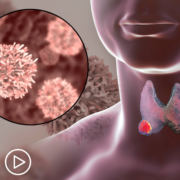Overcoming Thyroid Cancer Care Barriers
Overcoming Thyroid Cancer Care Barriers from Patient Empowerment Network on Vimeo.
What are some thyroid cancer barriers to care and treatment? Expert Dr. Megan Haymart from the University of Michigan discusses obstacles that disadvantaged patients may encounter and proactive patient advice to help ensure their best care.
[ACT]IVATION TIP
“…ask your surgeon, how many operations have you done within the past year? High volume surgeons typically do 25 or more. And so I think that’s really important because you’re going to have a lower risk of complications. And so I would encourage all patients to speak up and to make sure they ask these questions.”
See More from [ACT]IVATED Thyroid Cancer
Related Resources:

Thyroid Cancer Explained: Types, Staging, and Patient Communication |

|

Understanding Thyroid Cancer Treatment Options and Follow-Up Care |
Transcript:
Lisa Hatfield:
Dr. Haymart, what are the current barriers that disadvantaged patient populations face in receiving a timely diagnosis and, even more important, treatment of their thyroid cancer?
Dr. Megan Haymart:
So there are disparities in the care of thyroid cancer patients from diagnosis to treatment and even survivorship. For diagnosis, we know that there are certain groups that are at higher risk for presenting with advanced stage disease, so especially minority populations, Black and Hispanic. We don’t know why that is. We don’t fully know why that is at least, but my activation tip for diagnosis would be that if you feel a lump in your neck that doesn’t go away after a few weeks, especially lower in your neck, talk to your doctor.
We also see disparities in treatment. And I think we know a little bit more about why those occur. So there’s been recent data by Dr. Chen, who works with my group, who found that when patients call to get into the clinic, if they don’t speak English as their primary language, if they speak Spanish or Mandarin, they may have difficulty getting into the clinic for a visit. And so we think there are language barriers that occur.
We also know that there’s differences in treatment based on what doctors patients are seeing. So if patients are seeing low volume surgeons who don’t do a lot of operations, they may not get the best treatment for them, which could lead to downstream consequences, including increased risk of recurrence or complications from the surgery itself.
And so my activation tip for this question is that if English is not your primary language and if you run into obstacles scheduling an appointment, if you have any family members or friends that speak English that you can pull in to help you, I think that’d be important. Hopefully, eventually the system will be better where that’s no longer an obstacle, but for now I think that’s important to know.
And then my other activation tip for this question is, you want to make sure you know who your surgeon is in regards to if they’re a high or low volume surgeon. That’s extremely tricky to know, even for me as a physician. I know thyroid cancer because I do thyroid cancer, but if you asked me about GI cancer, I wouldn’t know. And so you have to ask your surgeon, how many operations have you done within the past year? High volume surgeons typically do 25 or more. And so I think that’s really important because you’re going to have a lower risk of complications. And so I would encourage all patients to speak up and to make sure they ask these questions.
Lisa Hatfield:
Okay, thank you. Would it be appropriate for a patient to ask specifically how many of those surgeries that physician has done every year?
Dr. Megan Haymart:
Yeah, it’s totally appropriate to ask because you can’t find that information on the web. So unless you have a doctor colleague or a friend who knows thyroid well, and knows who those high volume surgeons are, they might be able to identify them. But otherwise, if you’re just referred to your local surgeon, I think it’s very appropriate to ask them, how many surgeries have you done in the past year? What are some of the complications that might happen? How often do you see that in your patient setting? I think those would be very appropriate questions.











